Nov 25 2020
An international group of astronomers has found that CK Vulpeculae, observed first in 1670 as a bright new star, is located almost five times distant than considered earlier. The discovery was made with the help of Gemini North’s GNIRS instrument.
 CK Vulpeculae seen with Gemini North. Image Credit: International Gemini Observatory/NOIRLab/NSF/AURA.
CK Vulpeculae seen with Gemini North. Image Credit: International Gemini Observatory/NOIRLab/NSF/AURA.
This renders the 1670 explosion of CK Vulpeculae considerably more energetic compared to what was estimated earlier and places it into a mysterious family of objects too bright to be members of the well-perceived kind of explosions called novae, but too faint to be supernovae.
A bright new star was observed to flare into life in the Vulpecula constellation by the French monk Anthelme Voituret 350 years ago. In the subsequent months, the star turned nearly as bright as Polaris (the North Star) and was tracked by some of the pioneering astronomers of the day before it disappeared after a year.
Thus, the new star got the name CK Vulpeculae and, for a long time, was regarded as the first documented example of a nova—a transient astronomical event caused by an explosion in a close binary star system where one member is a white dwarf, or the remnant of a Sun-like star. But a series of latest results have questioned the long-established classification of CK Vulpeculae as a nova into doubt.
In 2015, a team of astronomers proposed that the appearance of CK Vulpeculae in 1670 was the outcome of a cataclysmic collision between two normal stars. The same team, in 2018, further suggested that one of the stars is actually a bloated red giant star, according to their discovery of a radioactive isotope of aluminum in the close surroundings of the 1670 explosion site.
This concept was even more complicated by another group of astronomers, who suggested a different interpretation. In their study, which was also published in 2018, they proposed that the abrupt brightening in 1670 was due to the merger between a white dwarf and a brown dwarf—a failed star too small to glow through thermonuclear fusion that drives the Sun.
At present, apart from the ongoing enigma related to CK Vulpeculae, fresh observations from the international Gemini Observatory, a Program of NSF’s NOIRLab, show that this mysterious astronomical object is located quite farther and has emitted gas at considerably higher speeds than reported earlier.
Headed by Dipankar Banerjee of Physical Research Laboratory Ahmedabad, India, Tom Geballe of Gemini Observatory, and Nye Evans of Keele University in the United Kingdom, the new team first intended to employ the Gemini Near-Infrared Spectrograph (GNIRS) instrument on Gemini North on Hawai‘i’s Maunakea to confirm the 2018 finding of radioactive aluminum at the core of CK Vulpeculae.
The astronomers realized that it would be much more challenging to detect this in the infrared compared to what was considered earlier. Therefore, they improvised and acquired infrared observations over the entire extent of CK Vulpeculae, which included the two wisps of nebulosity at its outermost edges.
The key to our discovery was the GNIRS measurements obtained at the outer edges of the nebula. The signature of redshifted and blueshifted iron atoms detected there shows that the nebula is expanding much more rapidly than previous observations had suggested.
Tom Geballe, Astronomer, Gemini Observatory
According to Banerjee, astronomer and lead author of the study, “We did not suspect that this is what we would find. It was exciting when we found some gas traveling at the unexpectedly high speed of about 7 million km/hour. This hinted at a different story about CK Vulpeculae than what had been theorized.”
The astronomers measured the speed of expansion of the nebula and the extent of movement of the outermost wisps in the past decade, as well as considered the tilt of the nebula on the night sky, which other astronomers had previously estimated, to find that CK Vulpeculae is located roughly 10,000 light-years away from the Sun—nearly five times as far away as considered earlier.
This indicates that the 1670 explosion was much brighter, discharging approximately 25 times more energy compared to what was estimated earlier. Such a considerably higher estimate of the amount of energy discharged implies that the event that led to the sudden appearance of CK Vulpeculae in 1670 was much more violent compared to a simple nova.
In terms of energy released, our finding places CK Vulpeculae roughly midway between a nova and a supernova. It is one of a very few such objects in the Milky Way and the cause—or causes—of the outbursts of this intermediate class of objects remain unknown. I think we all know what CK Vulpeculae isn’t, but no one knows what it is.
Nye Evans, Astronomer, Keele University
The CK Vulpeculae nebula’s visual appearance and the high velocities noticed by the team could be useful for astronomers to identify the relics of analogous events—in external galaxies or in the Milky Way—that have happened in the past.
It is difficult at this stage to offer a definitive or compelling explanation for the origin of the 1670 eruption of CK Vulpeculae. Even 350 years after Voituret’s discovery, the nature of the explosion remains a mystery.
Dipankar Banerjee, Astronomer, Physical Research Laboratory Ahmedabad